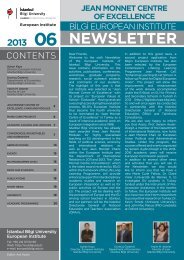WP2 Turkey: Country Report - İstanbul Bilgi Üniversitesi | AB Enstitüsü
WP2 Turkey: Country Report - İstanbul Bilgi Üniversitesi | AB Enstitüsü
WP2 Turkey: Country Report - İstanbul Bilgi Üniversitesi | AB Enstitüsü
Create successful ePaper yourself
Turn your PDF publications into a flip-book with our unique Google optimized e-Paper software.
Social Impact of Emigration and Rural-Urban Migration in Central and Eastern Europe<br />
VT/2010/001<br />
4. Labour Market and Social Development Trends in Net Migration Loss / Gain Regions<br />
4.1. Identification of Net Migration Loss / Gain Regions<br />
We use Statistical Institute’s figures on net migration rates and the ratio to population at<br />
NUTS1 level regions to identify the regions with net in- and out-migration. These figures<br />
reflect changes in population, hence incorporating both internal migration and emigration.<br />
Table 8 provides the figures for periods 1975-1980, 1980-1985, 1985-1990, 1995-2000, and<br />
2007-2010. 2007-2010 figures are based on new census methods and hence differences<br />
with earlier periods should be commented on with caution. As seen from statistics, western<br />
parts of the country, excluding Western Black Sea region, receive migration while the<br />
eastern parts provide migrants. Istanbul is the major destination for migrants. Among the<br />
sources of migration, northern parts rank first; we observe little difference across time in<br />
migration patterns. The only switch from out- to in- migration occurs with Western Marmara.<br />
Eastern and western regions of <strong>Turkey</strong> differ considerably in terms of geographic,<br />
demographic and economic characteristics. Eastern regions have rough geographical<br />
structure, which restricts industrial investments as well as agricultural activities. Climate is<br />
harsh in eastern and south-eastern regions. Economic development level decreases<br />
considerably from western to eastern and to northern regions. Regional GDP statistics are<br />
available only for the period 1987-2001. Hence we display the figures for 1990 and 2000 in<br />
Table 9. In-migration regions have often more than double the GDP of out-migration regions.<br />
Regarding demographics, Table 10 presents some statistics from the year 2009. We find inmigration<br />
regions to be highly urban compared to out-migration regions. While the ratio of<br />
youth is rather homogeneous and around the national average in in-migration regions, it<br />
varies considerably among out-migration states. Variation arises from the differences<br />
between the Black Sea region where the ratio of youth is small and other out-migration areas<br />
where the ratio of youth is high. Finally, we find variation in the ratio of elderly. It should be<br />
also noted that fertility rates are much higher in eastern and south-eastern regions compared<br />
to the western regions. Unfortunately, due to lack of data we are unable to put the possible<br />
links between emigration and age ratios.<br />
4.2. Labour Market Development in Net Migration Loss / Gain Regions<br />
Those regions with positive net migration had in 2010 labour force participation (LFP) rates<br />
which were close to the national average of 48%. In other regions we observe a wide<br />
variation. In Eastern Black Sea region, mostly because of agricultural employment (which<br />
constitutes 54% of employment) and high female workforce use in agriculture, we observe<br />
high labour force participation of 58%. These, however, are usually self-employed<br />
subsistence farmers. In Central, Central-Eastern and South-East Anatolia the share of<br />
agriculture in employment varies as 33%, 40%, and 27%, respectively; but LFP rate goes<br />
down to 45% for Central and Central-Eastern Anatolia, and 37% for South-East Anatolia (see<br />
Table 11; the figures are from Labor Force Statistics 2010, compiled by TUIK).<br />
The unemployment rate is higher in net positive migration regions compared to the net<br />
negative migration regions, though there are variations among the regions. In Istanbul the<br />
rate goes up to 14%, higher than the 12% figure of the national rate. Migration may be one of<br />
the reasons behind the difference. In Western Marmara region, another region of inmigration,<br />
it is only 8.8%. In out-migration regions we observe a similar variation as above<br />
where South-Eastern regions have a high and North-Eastern region have a low<br />
unemployment rate relative to the national average (see Table 11; the figures are from Labor<br />
Force Statistics 2010, compiled by TÜİK). These figures are largely related to the agricultural<br />
activities, female activities in rural areas and similar characteristics, and are not telling much<br />
as to the impact of migration. Indeed, the correlation across regions in 2010 between net<br />
migration rate and unemployment figures stay only at 0.14. The ones for labour force<br />
participation and the inactivity rate (which is the proportion of the population that is not in the<br />
labour force and when added together, the inactivity rate and the labour force participation<br />
rate will sum to 100 per cent) are similarly low at -0.09 and 0.09, respectively.<br />
Final <strong>Country</strong> <strong>Report</strong> <strong>Turkey</strong> 16



